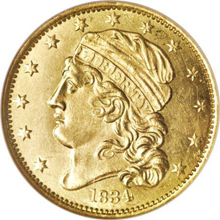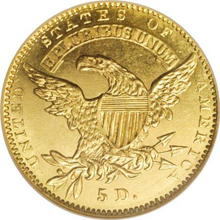 1834 $5 Capped Head, Crosslet 4 MS64 NGC. Ex: Freedom Collection. B. I-3, Breen-6500, Bass-3166, BD-2, R.5. The final "old tenor" design type was coined from 1829 through early 1834, with few surviving examples. Although Mint records suggest that more than 700,000 of these coins were produced from 14 different die combinations, the total estimated population today is less than 400 coins with a cumulative total of 284 to 370 pieces according to John Dannreuther, including 80 to 100 examples of this date alone. Some numismatists will be surprised to learn that the 1834 With Motto half eagle is the most plentiful date of this design type.
1834 $5 Capped Head, Crosslet 4 MS64 NGC. Ex: Freedom Collection. B. I-3, Breen-6500, Bass-3166, BD-2, R.5. The final "old tenor" design type was coined from 1829 through early 1834, with few surviving examples. Although Mint records suggest that more than 700,000 of these coins were produced from 14 different die combinations, the total estimated population today is less than 400 coins with a cumulative total of 284 to 370 pieces according to John Dannreuther, including 80 to 100 examples of this date alone. Some numismatists will be surprised to learn that the 1834 With Motto half eagle is the most plentiful date of this design type.
The actual mintage figures have no relationship to the rarity of these pieces today. Newly minted half eagles during the 1820s and early 1830s were immediately worth a premium, and were hoarded and melted in this country, or exported. In the Harry W. Bass, Jr. Sylloge, Dave Bowers relates: "Beginning by the autumn of 1821, virtually all half eagles were exported, a situation that remained in effect through the summer of 1834. Even the Philadelphia Mint would pay a premium over face value for contemporary half eagles! Thus, striking was specifically to the order of bullion depositors who realized that a freshly-minted $5 would be worth more than face value, and that on the international market it could be exchanged for its bullion value. At foreign destinations such as London and Paris, American half eagles would be melted and converted into national coinage--to facilitate exchange, accounting, and trade. Although hundreds of thousands of Type IV [1813-1829, Type V was issued from 1829-1834] half eagles were struck, only a few survived exportation and subsequent melting. Thus, the general mintage figures in no way relate to the availability of such pieces today."
 The Coinage Act dated June 28, 1834 reduced the weight of half eagles to 129 grains of standard 899.2 fine gold. The previous standard had been 135 grains of 916.7 fine gold. These standards yielded a gold value of $5.33 for the old standard pieces. The new standard, accompanied by the new Classic Head design, took effect on August 1, 1834. It is fascinating to learn that the most prolific private gold manufacturer in the country at that time, Christian Bechtler, adapted the new standard to his coinage as well. In fact, one of the Bechtler five dollar gold pieces actually includes the August 1, 1834 date as part of the design. The Bechtler piece actually contains 116.67 grains of pure gold instead of 116 grains, about three cents' worth of extra gold at the time.
The Coinage Act dated June 28, 1834 reduced the weight of half eagles to 129 grains of standard 899.2 fine gold. The previous standard had been 135 grains of 916.7 fine gold. These standards yielded a gold value of $5.33 for the old standard pieces. The new standard, accompanied by the new Classic Head design, took effect on August 1, 1834. It is fascinating to learn that the most prolific private gold manufacturer in the country at that time, Christian Bechtler, adapted the new standard to his coinage as well. In fact, one of the Bechtler five dollar gold pieces actually includes the August 1, 1834 date as part of the design. The Bechtler piece actually contains 116.67 grains of pure gold instead of 116 grains, about three cents' worth of extra gold at the time.
Although the 1979 photograph makes plate matching difficult, we are quite certain that this example is from the famous Garrett Collection, sold on behalf of Johns Hopkins University by Bowers and Ruddy in a series of four sales from 1979 to 1981. A tiny rim bruise directly above star 7 appears to match the photo of the Garrett coin. Despite a few insignificant abrasions, this is a lovely example with bright greenish yellow-gold color and full prooflike surfaces. The obverse has a die crack joining stars 9 through 13. John Dannreuther described different die cracks for his Die State b, but the other crack from the rim to cap at the right side of star 6 is not visible on this piece. The reverse has a crack through MERICA and the denomination.
Apparently Ex: John W. Haseltine (69th Sale, 6/1883); Garrett Collection; Johns Hopkins University (Bowers and Ruddy, 11/1979), lot 477. © 2007. Heritage Galleries. Used with permission.